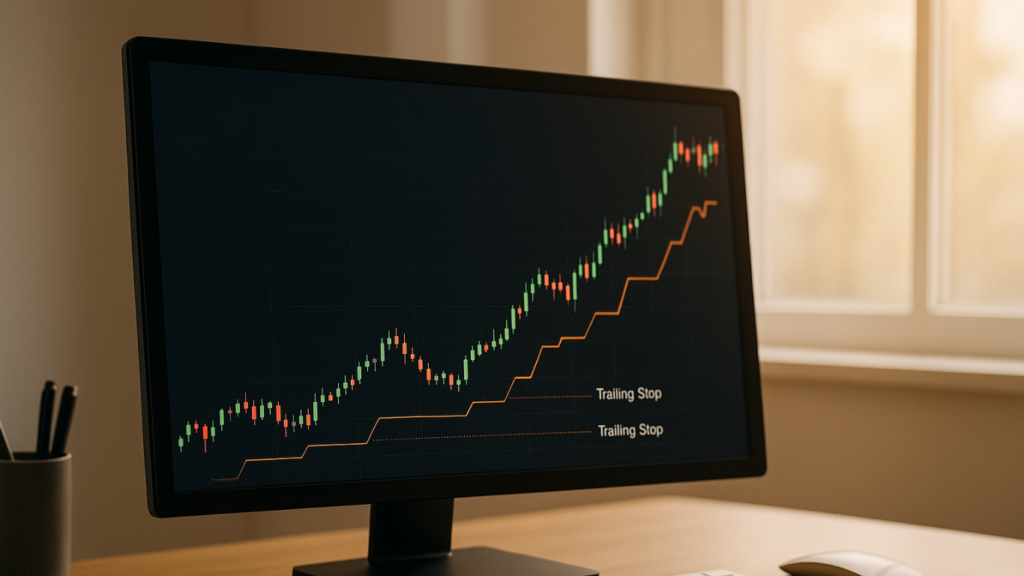Trailing stops are a trading tool that helps you secure profits while managing risk. They automatically adjust as the market moves in your favour, maintaining a set distance from the highest price reached. This ensures you lock in gains without constantly monitoring the market. Here’s what you need to know:
- What it does: Protects your profits by trailing the market price upward (for long positions) or downward (for short positions). If the price reverses by a set amount, it triggers a sell.
- Why it matters: It removes emotions from trading, helps you stick to predefined rules, and allows your trades to capture upward trends while limiting losses.
- How to set it up: Choose a trailing amount (fixed value or percentage), and your trading platform will handle the rest. For SGX stocks, ensure your broker supports this feature.
- Key consideration: The trailing distance must balance market volatility. Too tight, and you risk premature exits; too wide, and you might not protect profits effectively.
Trailing stops work best in trending markets but can struggle in volatile or sideways conditions. They’re ideal for traders who can’t monitor trades constantly, especially during SGX trading hours (9:00 AM to 5:00 PM SGT). Learn how to use them effectively by refining your settings, tracking results, and aligning them with your risk tolerance.
How Trailing Stops Work: A Step-by-Step Guide
Trailing stops are a handy tool for protecting your profits while keeping up with market changes. Here’s how they work.
Setting Up Trailing Stop Orders
To get started, log in to your trading platform, find the stock you want to trade, and select the ‘Trailing Stop’ option.
You’ll then need to set your trailing amount. This can be a fixed amount in SGD (e.g., SGD 0.50) or a percentage (e.g., 5%). For stocks listed on the Singapore Exchange (SGX), most platforms will automatically format your input in SGD for convenience.
Before submitting your order, double-check the stock symbol, quantity, and the trailing distance you’ve set. Once you’re sure everything is correct, confirm and submit your order.
A few things to keep in mind for traders in Singapore: Not all platforms support trailing stops for SGX stocks, so confirm this with your broker. Trailing stops usually work during SGX’s standard trading hours (9:00 AM to 5:00 PM SGT) and must adhere to minimum price increments – typically SGD 0.01 for most stocks. Some platforms may also have restrictions based on order sizes or specific stock types, so it’s always a good idea to verify these details with your broker beforehand.
Once your trailing stop is set, it will automatically adjust as the market moves.
How Trailing Stops Move
Trailing stops are designed to follow rising prices but stay locked in place when prices drop.
For a long position, the trailing stop moves upward as the stock hits new highs, maintaining the set distance from the peak price. However, if the stock price starts to fall, the stop price remains fixed at its last high point. This mechanism helps preserve your gains while allowing room for upward trends.
Here’s an example: Suppose you set a trailing stop SGD 0.50 below the highest price. If the stock climbs from SGD 10.00 to SGD 10.80, your stop price will move from SGD 9.50 to SGD 10.30, maintaining that SGD 0.50 gap. If the stock price then drops, your stop price stays at SGD 10.30 until it’s triggered.
When the trailing stop is triggered – if the stock price falls or gaps down past your stop price – it converts into a market order. This means the order will execute at the next available price. In fast-moving or less liquid markets, this could result in slippage, where the execution price is less favourable than your stop price.
This system is particularly useful for active traders dealing with SGX stocks.
Example: Using Trailing Stops on Singapore Stocks
Let’s say you buy 1,000 shares of DBS at SGD 30.00 and set a trailing stop SGD 1.00 below the peak price. Initially, your stop price is set at SGD 29.00.
As DBS rises to SGD 32.00, your trailing stop automatically adjusts to SGD 31.00, keeping that SGD 1.00 buffer below the peak. If the stock continues climbing and hits SGD 33.50, your stop price moves up to SGD 32.50, locking in a profit of SGD 2.50 per share.
Now, if market sentiment shifts and DBS starts declining, dropping from SGD 33.50 to SGD 32.00, your stop price remains fixed at SGD 32.50. The moment the stock price touches SGD 32.50, your trailing stop is triggered and converts into a market order. Assuming the order executes at around SGD 32.50, you’ve secured a profit of SGD 2.50 per share.
This example highlights how trailing stops help you ride upward trends while protecting yourself from significant losses when the market turns. The key is setting a trailing distance that balances market volatility with your profit goals.
Pros and Cons of Trailing Stops
Expanding on the dynamic nature of trailing stops, this section dives into their advantages and limitations. Knowing both sides can help you decide when and how to use them to maximise your trading outcomes.
Benefits of Trailing Stops
Trailing stops are a hands-off way to protect your profits around the clock. For Singaporean traders juggling work during SGX trading hours (9:00 AM to 5:00 PM SGT), this feature is especially handy. You don’t need to be glued to your screen, as trailing stops adjust automatically based on price movements.
They also help take the emotion out of trading. By sticking to preset rules, you avoid the stress of deciding when to sell and the temptation to hold onto winning positions for too long. This can be a game-changer, especially if you’ve ever second-guessed yourself mid-trade.
Trailing stops shine in trending markets, where they let you ride the upward momentum while safeguarding against sudden downturns. Unlike fixed profit targets, trailing stops allow your winning trades to run longer, potentially boosting your returns.
Drawbacks of Trailing Stops
That said, trailing stops aren’t without risks. One major issue is premature exits during volatile periods. Singapore stocks, for instance, can experience sharp price swings. If your trailing stop is set too tight, it might trigger during normal fluctuations, forcing you out of a position just before it rebounds.
Another challenge is order slippage. When a trailing stop converts to a market order, the actual execution price might differ from your intended stop level. This is more common in fast-moving or less liquid markets, such as smaller SGX-listed companies with lower trading volumes.
Setting the wrong trailing distance can also backfire. If it’s too tight, you risk frequent premature exits. If it’s too wide, you might not get enough protection against reversals. Striking the right balance requires a good grasp of the stock’s typical price behaviour and current market conditions.
Lastly, trailing stops can struggle in choppy markets. When prices move sideways with frequent ups and downs, these stops can trigger unnecessarily, leading to multiple small losses instead of letting your position recover from temporary volatility.
| Aspect | Benefits | Drawbacks |
|---|---|---|
| Execution | Automatic | Risk of slippage |
| Profit Protection | Locks in gains as prices rise | May exit too early during normal fluctuations |
| Emotional Control | Removes guesswork and emotions | Requires proper distance setting |
| Market Conditions | Works well in trending markets | Struggles in choppy conditions |
When to Use Trailing Stops
Balancing the pros and cons helps clarify when trailing stops are most effective. They work best in markets with strong trends, where they can follow the momentum and lock in profits while allowing room for further gains.
They’re also ideal if you can’t actively monitor your trades. For instance, if you’re holding SGX stocks but are tied up with work during trading hours, a trailing stop provides automated protection.
However, trailing stops are less suitable in highly volatile or sideways markets. During earnings season or major economic announcements, increased price swings could trigger stops prematurely, making them less effective.
Your position size and risk tolerance should also guide your decision. For larger positions where protecting profits is key, trailing stops can be invaluable. For smaller, more experimental trades, you might prefer fixed stops or manual monitoring to ride out the volatility.
Tools like the Average True Range (ATR) can help you determine the right conditions for trailing stops. Higher ATR values signal increased volatility, which might require wider trailing distances or alternative strategies.
Before using trailing stops, take a close look at the stock’s price patterns and recent trading activity. Some SGX stocks naturally have wider daily ranges, which means they’ll need different trailing distances compared to steadier blue-chip counters. Align your strategy with your market analysis and your comfort with risk.
Master Systematic Trading with Collin Seow
Learn proven trading strategies, improve your market timing, and achieve financial success with our expert-led courses and resources.
Using Trailing Stops in Systematic Trading
Incorporating trailing stops into a systematic trading strategy can help improve discipline and outcomes. By removing guesswork and emotions, systematic trading makes trailing stops even more effective as part of a structured approach.
Systematic Trading Basics
Systematic trading is all about discipline, consistency, and following rules. Instead of reacting impulsively to market noise, you stick to predefined rules for every trade. Trailing stops, as mentioned earlier, act as an automated safety net, and systematic trading integrates them seamlessly into its framework.
“Collin Seow’s trading methodology stands out through its systematic and strategic approach, particularly in addressing the critical aspects of trading: what to buy, when to buy, and how much to buy.”
Systematic trading addresses three key questions: What to buy, when to buy, and how much to buy. To decide what to buy, traders focus on identifying strong stocks using comparative strength analysis and solid fundamentals. Timing the entry is based on technical analysis and trends in the market. Finally, determining how much to buy involves strategic position sizing, tailored to the trader’s risk tolerance and the trade’s risk-reward ratio.
For Singapore traders balancing a full-time job during SGX trading hours (9:00 AM to 5:00 PM SGT), systematic trading with trailing stops offers a practical solution. It provides automated protection, reducing the need for constant monitoring during the trading day. This is especially useful for trading SGX stocks, where price movements can be sharp and sudden.
“His approach is not just about making successful trades but about cultivating a strategic and disciplined mindset among his students.”
At Collin Seow Trading Academy, the emphasis is on helping traders avoid the emotional pitfalls of discretionary trading. By adhering to a set of rules, traders can maintain consistency across all market conditions, whether dealing with highly volatile small-cap SGX stocks or more stable blue-chip shares.
Setting the Right Trailing Distance
Once you’ve built a systematic framework, the next step is to determine the right trailing stop parameters. This requires a calculated approach, especially when trading in Singapore markets. Trailing stops can be set using fixed amounts (e.g., S$0.20 below the current price), percentages (e.g., 5% below the highest price), or volatility-based indicators like the Average True Range (ATR).
For SGX stocks, ATR-based trailing stops often work well. For instance, if a stock typically moves S$0.10 per day based on its ATR, setting a trailing stop at S$0.20–0.30 allows for normal price fluctuations while protecting against significant reversals. This method adapts to each stock’s volatility profile.
Here’s a practical example: Suppose you buy a Singapore stock at S$2.00 per share and set a 5% trailing stop. If the stock rises to S$2.20, the trailing stop adjusts to S$2.09 (5% below S$2.20). If the price falls to S$2.09, the stop triggers, locking in a profit of S$0.09 per share, or S$90 for a 1,000-share position (before brokerage fees).
Market trends and technical analysis should also guide your trailing stop decisions. In strong trending markets, wider stops can help avoid premature exits. During choppy or uncertain periods, tighter stops may better protect your capital. The key is to stay consistent with your rules while adapting to market conditions.
Your risk tolerance and the trade’s risk-reward ratio play a big role in setting the appropriate trailing distance. Stocks with strong momentum might need wider stops to accommodate normal pullbacks, while speculative or weaker positions may call for tighter stops to limit losses.
Risk Management and Position Sizing
With your trailing stop parameters in place, the next step is to align them with effective risk management practices. Trailing stops work best when paired with proper position sizing and other risk controls, helping to protect your capital while maximising potential gains.
“The question of how much to buy is central to managing investment risk. Collin’s approach emphasizes strategic position sizing, which involves determining the appropriate investment amount for each trade based on an individual’s risk tolerance and the trade’s risk-reward profile.”
Position sizing is a key part of risk management. For example, if your maximum risk per trade is S$500 and your trailing stop is set S$0.10 below the entry price, you can buy up to 5,000 shares (S$500 ÷ S$0.10 = 5,000 shares). This ensures that even if the stop is triggered immediately, your loss stays within your risk limit.
You can refine this further by adjusting position sizes based on the stock’s strength and market conditions. Stronger stocks identified through systematic analysis may justify larger positions with wider trailing stops, while weaker stocks might call for smaller positions and tighter stops. This balanced approach helps optimise your risk-reward ratio across your portfolio.
Diversification is another critical aspect of risk management. Instead of concentrating your capital in just one or two SGX stocks, spreading your investments across different sectors and market caps reduces overall risk. If a trailing stop is triggered on one position, the impact on your portfolio remains manageable.
Regularly reviewing how your trailing stops perform is equally important. By analysing their effectiveness across various market conditions and stock types, you can fine-tune your approach. This might involve tweaking trailing distances, adjusting position-sizing rules, or identifying which SGX sectors align best with your strategy.
The combination of trailing stops and systematic trading offers a powerful advantage: automated profit protection and reduced emotional interference. With your rules handling the decision-making, you can focus on spotting new opportunities and improving your overall strategy, rather than second-guessing individual trades.
Tips and Common Mistakes to Avoid
When incorporating trailing stops into your trading strategy, it’s essential to understand how to navigate dynamic market conditions. Singapore traders, in particular, often fall into avoidable traps that can impact their results.
Best Practices for Trailing Stops
Stay on top of your orders. Keep an eye on your trades during SGX trading hours (9:00 AM to 5:00 PM SGT) to manage risks like market gaps and slippage.
Tailor your trailing distance to the asset’s volatility. Use tools like the Average True Range (ATR) to determine an appropriate trailing distance. For highly volatile SGX stocks, a wider trailing stop can help avoid premature exits. On the other hand, less volatile blue-chip stocks, such as DBS or OCBC, might allow for tighter stops.
Adapt your strategy to market conditions. When markets are trending, tighter stops can lock in profits. In more volatile conditions, giving your trades more breathing room with wider stops may be a better approach.
Account for all costs. Don’t overlook SGX fees, brokerage commissions, or bid-ask spreads. These costs can eat into your profits, so ensure your trailing stop settings are aligned with your overall profitability.
Maintain a trading journal. Document your stop-loss settings and review the outcomes. Analysing this data can help you spot patterns and fine-tune your strategy over time.
Common Mistakes to Avoid
Setting stops too close to the current price. Tight stops can get triggered by normal market fluctuations, causing you to miss out on potential gains. For example, if a stock typically moves S$0.15 daily, a trailing stop set at S$0.10 could result in unnecessary stop-outs.
Ignoring trading costs. If you only focus on price movements and forget about SGX clearing fees or brokerage commissions, even seemingly profitable trades can turn into losses.
Using a one-size-fits-all approach. Volatility varies across SGX-listed stocks, so relying on a fixed percentage for trailing stops may not work. Adjust your settings based on each stock’s unique behaviour.
Failing to adapt to market phases. A strategy that performs well in a bull market may fall short during bearish or uncertain conditions. Singapore’s market often reacts sharply to global events, so your trailing stops should reflect these shifts.
Skipping backtesting. Without testing your trailing stop settings on historical data, you’re essentially trading without a safety net. Backtesting offers valuable insights into how your strategy might perform under different market scenarios.
Regularly revisiting and refining your approach can help you stay ahead and improve your trading outcomes.
Keep Learning and Improving
To strengthen your trading strategy, continuous learning is key. Markets evolve, and new tools and techniques emerge regularly. Staying informed can make all the difference. Collin Seow Trading Academy offers free e-courses, live webinars, and other resources to help traders master systematic strategies, including the effective use of trailing stops.
Participating in webinars or trading courses can deepen your understanding of risk management and systematic trading methods. The academy’s resources focus on practical applications tailored to SGX trading, helping you avoid common errors while building a disciplined and effective approach.
For more in-depth knowledge, consider reading books like The Systematic Trader v.2, which dives into systematic trading and how trailing stops fit into a broader risk management framework.
Finally, test any new trailing stop strategies through paper trading or with small position sizes before committing significant capital. Each trade offers lessons that can help you better navigate Singapore’s market conditions. By staying committed to learning and refining your approach, you can make trailing stops a powerful tool in your trading arsenal.
Conclusion: Why Trailing Stops Matter
Trailing stops act as an automated safeguard, helping you secure profits while managing risks effectively. Unlike fixed stop-loss orders, they adjust dynamically with favourable price movements, allowing you to lock in gains as markets trend upward. This makes them a valuable tool for capturing more upside potential while maintaining discipline in your trading approach.
One of the biggest advantages of trailing stops is their ability to eliminate emotional decision-making. By automating the exit process, they help traders avoid the pitfalls of holding onto winning trades for too long or selling prematurely out of fear.
Data reveals that automated exit strategies, like trailing stops, can significantly improve profit retention and minimise losses. This is especially vital for Singapore traders dealing with market volatility influenced by global events. In such conditions, having a systemised approach to exits becomes even more important.
Collin Seow, a trading expert, highlights the importance of informed decision-making in trading:
“Success in trading is not just about making decisions; it’s about making informed decisions.” – Collin Seow
To use trailing stops effectively, traders need to focus on continuous learning and refining their strategies. This includes understanding market volatility, setting appropriate trailing distances with tools like the Average True Range, and adapting to different market conditions. When combined with other elements like stock selection, strategic timing, and position sizing based on individual risk tolerance, trailing stops become even more impactful.
For traders aiming for long-term success, trailing stops are a crucial part of a disciplined trading strategy. By incorporating them into a broader methodology and leveraging resources like the courses, webinars, and guides offered at Collin Seow Trading Academy (https://collinseow.com), traders can develop the skills and mindset needed to navigate Singapore’s dynamic market environment. Trailing stops not only help secure profits but also give your winning trades the room they need to grow.
FAQs
How do I choose the right trailing stop distance for SGX stocks to maximise profits while avoiding early exits?
Choosing the right trailing stop distance for SGX stocks involves considering factors like the stock’s volatility, your trading approach, and prevailing market conditions. Highly volatile stocks often need a wider trailing stop to accommodate their larger price swings, while less volatile stocks might suit a tighter stop.
A good starting point is to examine the stock’s average daily price movement or its average true range (ATR). For instance, you could set your trailing stop as a percentage of the ATR, allowing it to adjust to the stock’s usual price behaviour. Testing various trailing stop distances in a simulated trading environment can help you identify what aligns best with your strategy.
If you’re looking to refine your trading techniques, resources like those from Collin Seow Trading Academy offer helpful tools and insights to support your decision-making process.
How can I effectively use trailing stops to protect profits in a systematic trading strategy?
Trailing stops can be an excellent way to protect your profits while keeping your trades flexible enough to respond to market shifts. By using a trailing stop, your stop-loss level automatically adjusts as the market price moves in your favour. This means you can lock in gains without constantly monitoring your trades.
To effectively use trailing stops in a structured trading strategy, start by setting clear guidelines. Determine the percentage or dollar amount for your trailing stop based on how much risk you’re comfortable with and the asset’s volatility. The key here is consistency – your trailing stop approach should match your overall trading plan and goals.
If you want to sharpen your trading skills even more, it might be worth diving into educational materials or courses focused on systematic trading. These resources can help you develop a disciplined approach to managing your trades and optimising your profits.
How can I minimise risks like order slippage when using trailing stops in volatile or less liquid markets?
To reduce the risk of order slippage when using trailing stops in fast-moving or less liquid markets, it’s essential to adapt your approach to match the market conditions. Slippage happens when the market shifts too quickly or there isn’t enough liquidity to execute your trade at the expected price.
Here are some practical ways to manage this:
- Use wider trailing stop distances in highly volatile markets. This can help prevent your position from being closed too early due to sudden price swings.
- Steer clear of trading during major news announcements or periods of low liquidity, as these situations often lead to higher slippage risks.
- Keep a close eye on your trades in fast-moving markets so you can make manual adjustments if the situation calls for it.
Taking these steps can help safeguard your profits and minimise the effects of slippage on your trading outcomes.












